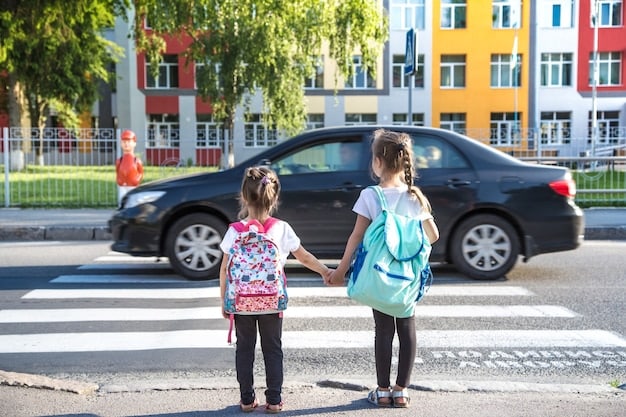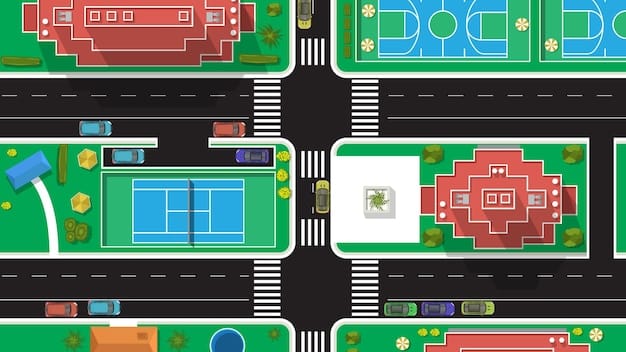School Zone Traffic Congestion: Practical Solutions for Parents and Schools

School Zone Traffic Congestion: Practical Solutions for Parents and Schools addresses the critical issue of traffic congestion around schools, offering actionable strategies for parents, schools, and communities to enhance safety, reduce delays, and create a more conducive environment for students.
Navigating the daily school rush can be a stressful experience for parents, students, and school staff alike. The challenge of school zone traffic congestion: practical solutions for parents and schools becomes paramount when considering safety and efficiency.
Understanding School Zone Traffic Congestion
School zone traffic congestion is a complex problem resulting from various factors. Identifying these causes is the first step towards developing effective solutions that benefit students, parents, and local communities.
Factors Contributing to Congestion
Several elements combine to create the challenging traffic conditions often seen around schools. These include the volume of vehicles, the timing of school bells, and the infrastructure surrounding the school.
- High volume of cars dropping off and picking up students.
- Inadequate parking and drop-off zones.
- Poorly timed traffic signals and lack of synchronization.
- Insufficient pedestrian and bicycle infrastructure.
Addressing these factors requires a multi-faceted approach, encompassing infrastructure improvements, policy changes, and community engagement.

By understanding the root causes of school zone traffic, communities can tailor solutions that address their unique challenges and optimize traffic flow.
Practical Solutions for Parents
Parents play a crucial role in alleviating school zone traffic congestion. By adopting smart strategies and changing habits, parents can contribute to creating a safer and more efficient environment for everyone.
Carpooling and Ride-Sharing
One of the most effective ways to reduce traffic is by sharing rides. Carpooling or using ride-sharing services can significantly decrease the number of vehicles on the road during peak hours.
Walking and Biking
Encouraging children to walk or bike to school can not only reduce traffic but also promote physical activity. Establishing safe walking routes and bike lanes is essential to supporting this option.
- Organize a walking school bus with neighborhood families.
- Ensure children have appropriate safety gear, such as helmets.
- Teach children about traffic safety and pedestrian rules.
These actions not only alleviate congestion but also foster a healthier lifestyle for children and families.
Ultimately, parents can become part of the solution by embracing alternative transportation methods and promoting responsible driving habits.
Strategies for Schools
Schools are uniquely positioned to implement strategies that mitigate traffic congestion within and around their campuses. Effective planning and policy implementation can make a significant difference.
Staggered Start and End Times
Adjusting school start and end times can help distribute traffic flow more evenly. Staggering schedules for different grade levels can prevent a sudden surge of vehicles.
Designated Drop-Off and Pick-Up Zones
Establishing well-organized drop-off and pick-up zones is crucial. Clear signage, designated lanes, and efficient procedures can streamline the process and reduce bottlenecks.
- Implement a color-coded system for different grades or areas.
- Use volunteer staff or parent volunteers to assist with traffic management.
- Ensure zones are clearly marked and accessible to all vehicles.
By taking proactive steps, schools can create a more orderly and safer environment for their students and staff.

School-led initiatives are essential for creating sustainable solutions to school zone traffic congestion.
Community Involvement and Infrastructure Improvements
Addressing school zone traffic requires a collaborative effort involving the entire community. Local governments, transportation agencies, and community organizations play a vital role in implementing long-term solutions.
Traffic Signal Optimization
Optimizing traffic signals around schools can significantly improve traffic flow. Synchronizing signals to accommodate school traffic patterns can reduce delays and prevent gridlock.
Pedestrian and Bicycle Infrastructure
Investing in pedestrian and bicycle infrastructure is essential for encouraging alternative transportation. This includes building sidewalks, bike lanes, and safe crossing points.
- Construct dedicated bike lanes leading to the school.
- Install pedestrian crosswalks with clear markings and signals.
- Improve street lighting to enhance safety during early morning and late afternoon hours.
Community-led initiatives are the key to creating safer and more accessible school zones.
By working together, communities can create a supportive environment for walking, biking, and using public transportation.
Leveraging Technology and Communication
Technology and effective communication can play a significant role in managing school zone traffic. Utilizing digital tools and platforms can help disseminate information and coordinate efforts.
Mobile Apps and Real-Time Updates
Mobile apps can provide real-time traffic updates, route suggestions, and parking availability information. Parents can use these apps to plan their trips and avoid congested areas.
Communication Platforms
Schools can use communication platforms to inform parents about traffic patterns, construction updates, and special events. This keeps parents informed and helps them adjust their schedules accordingly.
- Send out regular newsletters with traffic-related tips and updates.
- Use social media to share important announcements and traffic alerts.
- Create a dedicated webpage on the school website with traffic information.
These tools enable efficient communication and coordinated action, benefiting the entire school community.
Leveraging technology and enhancing communication are essential for creating adaptive and responsive solutions to traffic challenges.
Enforcement and Safety Measures
Enforcement and safety measures are critical components of any successful school zone traffic management plan. Ensuring compliance with traffic laws and promoting safe driving habits is paramount.
Increased Police Presence
Increasing police presence during school hours can deter speeding and other traffic violations. Visible enforcement can help create a safer environment for pedestrians and cyclists.
Crossing Guards
Deploying trained crossing guards at key intersections can provide added safety for students walking to and from school. Crossing guards help manage pedestrian traffic and ensure safe crossings.
- Conduct regular training sessions for crossing guards.
- Equip crossing guards with necessary safety gear, such as reflective vests and stop signs.
- Establish clear procedures for managing pedestrian traffic during peak hours.
These measures enhance safety and encourage responsible behavior around school zones.
Effective enforcement and safety measures are integral to safeguarding the well-being of students and promoting responsible driving.
| Key Point | Brief Description |
|---|---|
| 🚗 Carpooling | Sharing rides to reduce the number of vehicles. |
| 🚶 Walking/Biking | Encouraging active transport to decrease traffic. |
| 🚦 Signal Optimization | Improving traffic flow with signal adjustments. |
| 📱 Tech & Apps | Using technology for real-time updates and coordination. |
Frequently Asked Questions (FAQ)
▼
The primary causes include high vehicle volume during drop-off and pick-up times, inadequate parking and drop-off zones, and poorly timed traffic signals which exacerbate the problem.
▼
Parents can carpool, encourage walking or biking, adhere to designated drop-off zones, and avoid arriving too early to reduce the overall traffic volume in the school area.
▼
Schools can stagger start and end times, establish efficient drop-off and pick-up zones, and communicate effectively with parents regarding traffic patterns and alternative routes.
▼
Improvements include optimizing traffic signals, constructing sidewalks and bike lanes, and creating safe crossing points to encourage walking and biking to alleviate traffic.
▼
Technology can help via mobile apps that provide real-time traffic updates and schools communicating important traffic information through their websites and social media channels.
Conclusion
Addressing school zone traffic congestion: practical solutions for parents and schools requires a collaborative and comprehensive approach. By implementing a mix of strategies involving parents, schools, communities, and technology, we can create safer, more efficient, and less stressful environments for students and families.





